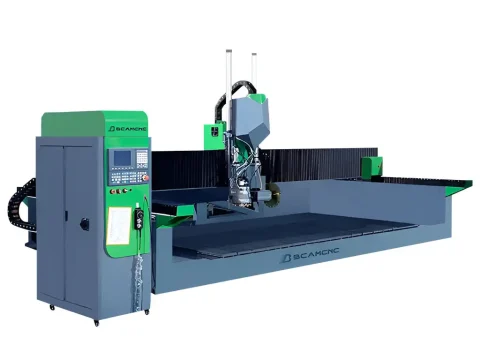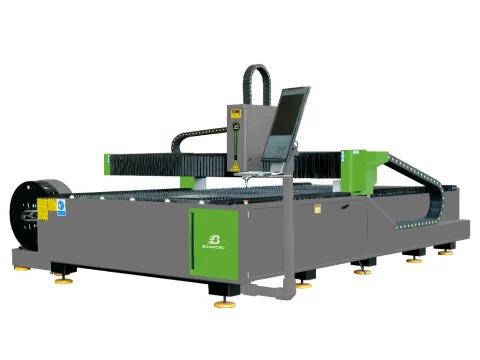Why Solid Wood Still Matters
Although MDF, particleboard, and plywood dominate mass production in the furniture industry, solid wood continues to play an essential role. Solid wood is durable, sustainable, and naturally beautiful, which makes it the top choice for premium furniture, flooring, doors, and decorative pieces.
Processing solid wood, however, requires more precision and care compared to engineered boards. Because of natural variations like knots, moisture, and grain direction, only specialized woodworking machinery can ensure consistent quality.
This article explores the role of woodworking machines for solid wood, detailing how each type is applied in real-world manufacturing. From band saws to CNC routers for solid wood, we will show why these technologies are vital in modern production.
Key Woodworking Machinery for Solid Wood
1. Band Saw for Solid Wood
The band saw is one of the most fundamental woodworking machines. Using a continuous blade, it makes both straight and curved cuts in solid timber.
Applications:
-
Resawing logs into planks.
-
Creating curved furniture components.
-
Cutting hardwood boards to size.
When paired with CNC controls, a band saw for solid wood ensures minimal waste and consistent precision.
2. Panel Saw Woodworking Machine
For large planks and slabs, the panel saw (or beam saw) is the tool of choice. This woodworking machinery delivers fast, accurate cuts.
Applications:
-
Cutting solid wood panels for tables or cabinets.
-
Trimming boards for flooring production.
-
Nesting cuts to maximize yield and reduce waste.
A panel saw woodworking machine with CNC software is especially valuable for optimizing expensive hardwoods.
3. CNC Router for Solid Wood
The CNC woodworking machine has revolutionized furniture production. With software-driven automation, a CNC router for solid wood can carve, engrave, and cut with unmatched accuracy.
Applications:
-
Decorative carving on cabinet doors.
-
3D relief patterns for custom furniture.
-
Joinery such as mortise and tenon cuts.
-
Edge profiling and groove cutting.
For companies focusing on solid wood furniture production, a CNC router reduces labor costs while delivering highly detailed work.
4. Planer and Thicknesser Machines
To prepare rough lumber, a solid wood processing machine like a planer or thicknesser is essential.
Applications:
-
Flattening raw boards.
-
Achieving consistent thickness.
-
Preparing surfaces before assembly.
Digital controls ensure uniform results, which are critical in solid wood furniture manufacturing.
5. CNC Press Brake for Wood
Although traditionally used for metal, a CNC press brake for wood is increasingly adapted for woodworking. With precise digital control, it enables bending and forming solid wood veneers or laminated sheets.
Applications:
-
Creating curved solid wood panels.
-
Producing unique furniture shapes.
-
Precision forming for architectural woodwork.
This type of CNC woodworking machine brings new possibilities for design innovation.
6. Mortising and Tenoning Machines
Traditional joinery is vital for durable furniture. Modern mortising and tenoning woodworking machines automate this process.
Applications:
-
Frame and chair construction.
-
Producing accurate mortise and tenon joints.
-
Mass production with consistent quality.
Strong joints are crucial in solid wood furniture production, ensuring long life.
7. CNC Drilling and Hinge Machines
Accurate drilling is another area where CNC woodworking machines excel.
Applications:
-
Drilling hinge holes in cabinet doors.
-
Pre-drilling for screws and connectors.
-
Dowel holes for furniture assembly.
Automated CNC drilling machines for solid wood reduce errors and speed up production.
8. Wood Lathes (Including CNC Wood Lathes)
The wood lathe is essential for turning cylindrical solid wood parts.
Applications:
-
Chair and table legs.
-
Staircase spindles.
-
Decorative turned details.
With a CNC wood lathe, companies can mass-produce identical turned pieces with precision.
9. Wide Belt Sander Woodworking Machine
Surface finishing is critical in solid wood furniture. A wide belt sander woodworking machine ensures smooth, uniform surfaces.
Applications:
-
Sanding hardwood boards.
-
Preparing panels for paint or varnish.
-
Achieving consistent finishes for luxury furniture.
High-end furniture relies heavily on the performance of this solid wood processing machine.
10. Dust Collection Systems
Every woodworking machinery line needs proper dust collection.
Applications:
-
Removing sawdust from routers, saws, and sanders.
-
Protecting machine performance.
-
Ensuring worker health and safety.
Dust collection systems are not optional—they are an integral part of solid wood woodworking machines.
Challenges in Solid Wood Processing
Even with advanced machines, solid wood presents unique challenges:
- Moisture Control – Wood expands and contracts with humidity.
- Grain Direction – Incorrect cutting can cause tear-out.
- Variable Hardness – Different species require different tooling.
- Material Cost – Solid wood is expensive, so minimizing waste is critical.
By adopting CNC woodworking machinery, many of these challenges are reduced, leading to consistent and profitable results.
Future Trends in Solid Wood Machinery
-
Smart CNC woodworking machines with AI-driven optimization.
-
Automation and robotics for material handling.
-
Green manufacturing to reduce waste and energy.
-
Hybrid systems combining CNC routing, drilling, and sanding in one machine.
These innovations will make solid wood processing machines more efficient and sustainable.
Conclusion
Solid wood remains the material of choice for premium products, but it demands advanced machinery to process efficiently. From the band saw for solid wood and panel saw woodworking machine to the CNC router for solid wood, CNC press brake for wood, and wide belt sander woodworking machine, each tool plays a critical role in modern factories.
For manufacturers, investing in the right woodworking machinery for solid wood means:
-
Higher precision
-
Less waste
-
Stronger joints
-
Faster production
As global demand for natural, sustainable furniture and construction materials grows, the importance of CNC woodworking machines for solid wood will only increase.
In short, solid wood craftsmanship is no longer just about tradition — it’s about combining nature’s beauty with the power of modern technology.











